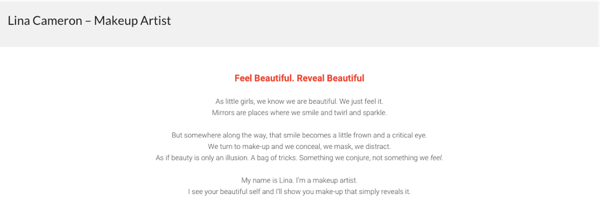How to develop empathy in copywriting to build trust with customers
Building trust with customers through copywriting has less to do with words or grammar, and everything to do with empathy. That’s because we buy on emotion and justify with logic. So whether it’s through joy, excitement, sadness or frustration – writing copy that teases out emotions helps prime potential customers for your solution.
Understanding your customers has to be one of your important tasks. Knowing what their pains, needs and desires are helps you to anticipate and mirror those thoughts, offer clarification where needed, and build trust.
We fail in building trust when our copy is more about us, our business, our product, and not about the customer. When we’re more concerned about our own needs – like getting more traffic, making more sales, growing our business – rather than finding out what our potential customers really want and need.
If you ignore your customers and don’t develop empathy in your copywriting, you are setting yourself up to fail. Today we’ll walk you through a few simple ways you can develop empathy in copywriting in order to build trust with your customers.
Create stories that tap into powerful emotions
Stories that tap into emotions can help you to connect more effectively with your target audience’s goals, perceptions and frustrations. In fact, researchers have found that synthesis of Oxytocin (the chemical that’s part of our ability to empathise) happens when we hear or read emotional, character-driven stories.
As a marketer, when you tease those unpleasant feelings of fear, sadness, frustration, you will better prime your potential customers for the solution you’re looking to promote. Take the Problem-Agitate-Solve formula for example. The formula works like this:
- Problem: Identify your reader’s pain point.
- Agitate: Stir it up so it hurts to the point of discomfort.
- Solve: Make your product or service the best solution available.
Here’s how you could write short sales copy for a pillow:
PROBLEM: When was the last time you had a really good night’s sleep? That kind of sleep where you wake up feeling so rested and excited about getting out of bed?
AGITATE: A bad night’s sleep can leave you feeling like no amount of coffee can get you moving or clear the fog in your brain. You can’t focus and you feel irritable.
SOLVE: If this happens too often, you’d better try our memory foam pillow. You won’t be sleeping. You’ll be floating.
So, why does this formula ALWAYS work?
It works because it forces you to present your product or service in the context of your customers. So rather than just talking about the cool features your product has or the cheap plans you’re offering, the formula provides you with a structure that forces you to think about your customers’ pain point. Then you can position your product or service as the solution to that particular problem.
By doing that, and by further agitating the problem and relating it to things your customers care about, you enhance their desire for your solution. Finally, your present them with the perfect fix, the solution that makes their problem vanish, compelling them to take the action you want them to take. That is to buy your product or service.
Keep in mind that there’s no way you can apply this formula successfully without first understanding your customers and their problems.
Steps to developing empathy in copywriting
Here’s how to do it:
Step 1: Define your ideal customer.
Think about your ideal customer, that person that you’d like to reach. Then take some time to define this target person, also referred to as “buyer persona”. Include details about their gender, age, geographic location, education, income level, job type and industry, family size, hobbies and more.
Here is a useful guide on how to identify them based on factors such as:
- Gender
- Age
- Location
- Industry
- Products they have bought before
- Previous purchase price
So any time you create a piece of copy, keep this document handy so you always remember who you’re writing for.
Step 2: Define their pains, fears and common problems that your product or service can solve.
Getting these insights can be as simple as talking to your customers or potential customers. You could survey your website visitors and ask them questions about what obstacles they’re facing. You can also send a questionnaire to your current and past customers to see what determined them to do business with you.
You can also spy on your competitors to see what pain points they are speaking to with a similar audience. You can even take a look at review sites like TrustPilot or marketplaces like Amazon to see what customers are talking about and what problems a product or service similar to yours have solved.
Reading your customers’ mind could be the best thing you do for the effectiveness of your copy (if only that were possible). Focusing on your own desires and needs is likely the worst.
Here are a few ways to research your competition with social media. This Swift Six video is also packed with useful advice on how to keep an eye on your competitors in order to gather information that you can use to your advantage.
Step 3: Describe all the ways your product or service solves those pain points.
Every time you discover a new customer problem or obstacle that’s related to your product, write it down and next to it write down how you can fix it. This way when you’re creating a piece of copy – whether it’s for your homepage, for a landing page, for an email newsletter or a Facebook ad – you’ll have a handy list of problems and problem-solving features that you can pull from.
Step 4: Create your storyline.
When you create a piece of copy, make sure to first come up with a fictional situation that involves your customer dealing with a particular pain point that your product can solve. For example, if your business offers plumbing services, your story could involve a frustrated family who is stressed out at their kids constantly clogging the toilet with their toys.
Step 5: Add in emotion.
When writing your copy, make sure you use words that your customers use when describing the situation you’re referring to. This helps make it more relatable to them. For example, when you’re referring to a pain point you could use words like “frustrating”, “complicated”, “exhausting”. When you’re highlighting the benefits of your product or service use words like “easy”, “life-saver”, “cheap”.
Step 6: Present your product or service as the simplest and best solution available to solve their problem.
Not only that, but also show how your solution helped other customers. You could add some testimonials from happy customers or from an authority in your industry that customers recognise and trust.
Now, let’s look at a few examples to see how businesses are leveraging empathy in their copy:
Trello presents the problems every person working on a project faces: “lengthy email threads, out-of-date spreadsheets, no-longer-so-sticky notes, and clunky software…”. They seal the deal by presenting the solution: “Trello is the free, flexible, and visual way to organise anything with anyone.”.
Here’s another great example from a make up artist:
This story reminds women of one of their biggest frustrations: no matter how hard they work to look healthy and younger, age catches up to all. Emotion triggered? Check! She then presents the solution: make up that reveals true beauty.
Wrapping up
Empathy is incredibly powerful. And if you follow these steps, your target audience will have a strong reason to take action and buy whatever it is that you’re selling. By creating a situation they can relate to, you’ll reap more benefits than if you continue to showcase the features of your product.
How are you using empathy in your copy? Share your thoughts and tips with us on our Facebook and Twitter channels.


